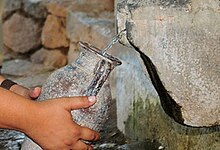Castalia
Castalia
Water deity
Castalia /kəˈsteɪliə/ (Ancient Greek: Κασταλία, romanized: Kastalia), in ancient Greek and Roman literature,[1] was the name of a spring near Delphi, sacred to the Muses; it is also known as the Castalian Spring. It is said to have derived its name from Castalia, a naiad-nymph, daughter of the river-god Achelous, who is said to have flung herself into the spring when pursued by the god Apollo.[2]
